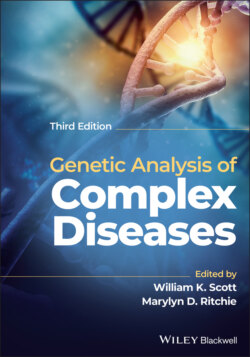Читать книгу Genetic Analysis of Complex Disease - Группа авторов - Страница 33
Historical Contributions Segregation and Linkage Analysis
ОглавлениеIn 1865, Gregor Mendel, an Austrian monk, published his findings on the inheritance of a series of traits in the pea plant, including seed texture (round or wrinkled), seed color (yellow or green), and plant height (tall or short). He described three properties of heritable factors that explained his quantified observations of these traits. The first property was the unit inheritance, which is now considered the basis for defining the gene. He hypothesized that a factor was transmitted from parent to offspring in an unchanged form. Such a factor produced an observable trait. This idea represented a radical departure from the scientific thinking at the time, which suggested parental characteristics were blended in the offspring.
Mendel also described the transmission of factors which were controlling observable traits, such as flower color or plant height as a single unit. He proposed that these factors were transmitted independently and with equal frequency to germ cells (egg and sperm) and this observation is referred to as Mendel’s first law, the law of segregation. In his experiments, Mendel crossbred the offspring (the F1 generation) of two phenotypically different, pure‐breeding parental strains of peas with one another. The offspring of these matings (the F2 generation) expressed the grandparental traits in a 3 : 1 ratio (Figure 2.1). Serendipitously, some of the traits Mendel had chosen to study were simple dominant traits, such that the presence of one factor was sufficient to express the trait, with the other trait being recessive (expressed only in the absence of the dominant factor). Later work showed that the factor defining a characteristic need not be dominant to the other. For instance, if each factor contributes to the trait equally, as in codominant systems, then three different classes of offspring from the same cross described above are possible: the two parental traits and a third intermediate trait. These classes occur in proportions parental to intermediate to parental of 1 : 2 : 1.
Mendel extended his observations from the transmission of a single trait from parent to offspring to the interaction of two traits. Mendel’s law of independent assortment, also referred to as Mendel’s second law, predicts that factors controlling different traits will segregate to offspring independently from one another. For instance, seed texture will segregate to offspring independently of seed color. In one experiment, Mendel crossed pure‐breeding round, green seed plants to pure‐breeding wrinkled, yellow seed plants. Since round is dominant to wrinkled and green is dominant to yellow, the resulting seeds (F1 generation) yielded entirely round, green seed plants. These F1 plants were then crossed with one another, confirming the predictions from his theory of independent assortment: The seed types (offspring) in the F2 generation were nine round/green, three round/yellow, three wrinkled/green, and one wrinkled/yellow, a ratio of 9 : 3 : 3 : 1 (Figure 2.2). Any observed departure from these expected ratios using identical parental crossing strategies suggests the two traits fail to segregate independently. As described later in the chapter, this may be a result of linkage, in which the genes for those traits are physically located near one another at a genetic region. We will describe later how the failure of two traits to segregate independently can be exploited to find genes and diagnose genetic disorders.
Mendel’s observations remained largely obscure until the early 1900s, when they were independently rediscovered by plant geneticists and by Sir Archibald Garrod, who was studying the human hereditary disorder alkaptonuria (Garrod 1902). Garrod’s work provided the basis of our understanding of alleles and genetic linkage, described later. Mendel’s observations remain one of the most important contributions of critical descriptive science in the history of genetics.
